 |
 |
 |
| |
Chronic liver disease and risk of mortality after COVID-19: a national, retrospective, cohort study for 2020
|
| |
| |
Chronic Liver Disease Boosts Odds of COVID-19 Death 80% in France
EASL International Liver Congress, June 23-26, 2021
Mark Mascolini
A national study in France linked chronic liver disease to about 80% higher odds of in-hospital death in COVID-19 patients, but liver disease did not affect chances of acute respiratory distress syndrome (ARDS) [1]. The 259,110-person study linked more advanced liver disease to a higher chance of in-hospital death. People with liver-related complications and alcohol use disorder had about a 25% lower chance of receiving mechanical ventilation. The study was recently published online [2].
Researchers used the French National Hospital Discharge database to identify everyone 18 or older discharged from one of 2187 hospitals or hospital groups with a COVID-19 diagnosis in France in 2020. They considered how two primary exposures affected this group, chronic liver disease (either compensated or advanced) and alcohol use disorders before COVID-19 reached France. The major outcomes were mechanical ventilation and 30-day in-hospital mortality.
This group consisted of 259,110 people with an in-hospital COVID-19 diagnosis. The group had a median age of 70 and 52% were men. Among these individuals, 15,476 (6%) had chronic liver disease and 243,634 (94%) did not. Men made up 61% of the group with chronic liver disease and 52% of the group without chronic liver disease, a highly significant difference (P < 0.001). The chronic liver disease group was slightly but significantly younger (69 vs 70, P < 0.001), more likely to have alcohol use disorder (23% vs 2.6%, P < 0.001), and more likely to smoke, be obese, have hypertension, have diabetes, and have a higher Charlson comorbidity index.
People with COVID-19 and chronic liver disease were more likely to get mechanical ventilation (10% vs 6.8% without chronic liver disease, P < 0.001) but no more likely to have ARDS (26% and 26%). The chronic liver disease group was more likely to have a history of acute kidney injury, renal replacement therapy, pulmonary embolism, acute liver failure, portal vein thrombosis, and liver disease progression. Day-30 in-hospital mortality proved significantly more likely in the group with chronic liver disease (19% vs 14%, P < 0.001).
Next the researchers determined how many of the 259,110 people with COVID-19 had invasive mechanical ventilation: 27,057 (10%) did and 232,053 (90%) did not. Among people with mechanical ventilation, 70% were men, while men made up 50% of the group without mechanical ventilation (P < 0.001). Age was significantly younger in people with mechanical ventilation (68 vs 71, P < 0.001).
Significantly higher proportions of people with invasive mechanical ventilation than without had alcohol use disorder (7.6% vs 3.4%), smoked (12% vs 5.1%), were obese (34% vs 15%), had hypertension (58% vs 42%), and had diabetes (36% vs 22%) (P < 0.001 for all comparisons). The mechanical ventilation group also had significantly higher proportions with chronic liver disease, alcoholic liver disease, chronic hepatitis B or C, mild liver disease, compensated cirrhosis, and decompensated cirrhosis (P < 0.001 for all). People who had mechanical ventilation were more likely to have a liver transplant (0.4% versus under 0.1%, P < 0.001) and more likely to have AIDS (0.7% vs 0.4%, P < 0.001).
Among these 259,110 people with COVID-19, 38,203 (15%) died within 30 days in the hospital and 220,907 (85%) did not. Men made up a higher proportion of the group that died than the group that survived (59% vs 51%, P < 0.001), and people who died were significantly older (83 vs 67, P < 0.001). The survivors had significantly higher proportions of smokers (5.9% vs 5.4%), obese people (17% vs 15%), and people with chronic HBV infection (0.3% vs 0.2%) (P < 0.001 for all). The group that died had higher proportions with alcohol use disorder (4.5% vs 3.8%), alcoholic liver disease (2.0% vs 1.3%), hypertension (58% vs 41%), diabetes (30% vs 23%), and chronic liver disease (7.7% vs 5.7%) (P < 0.001 for all).
Other conditions significantly more frequent in the group that died were compensated cirrhosis, decompensated cirrhosis, and primary liver cancer, whereas the survivors had higher proportions with mild liver disease and AIDS (P < 0.001 for all). Thus the analysis tied more advanced liver disease to a higher in-hospital death risk.
Independent risk factors for mechanical ventilation in the overall COVID-19 group were male sex, obesity, hypertension, and chronic liver disease. Factors that lowered chances of mechanical ventilation were alcohol use disorder, mild liver disease, compensated cirrhosis, decompensated cirrhosis, primary liver cancer, and being in the second COVID-19 pandemic wave in France.
Several variables independently raised chances of 30-day in-hospital mortality: older age category, male sex, alcohol use disorder, chronic liver disease (adjusted odds ratio 1.79, 95% CI 1.71 to 1.87, P < 0.001), decompensated cirrhosis, primary liver cancer, and a higher Charlson comorbidity index. Factors that independently lowered chances of dying in 30 days were mild liver disease, compensated cirrhosis, and being in the second pandemic wave in France.
The researchers proposed that more limited "therapeutic effort" may have contributed to COVID-19 deaths in people with chronic liver disease. They believe their findings indicate that people with chronic liver disease and alcohol use disorder should get prioritized for vaccination when vaccine supplies are limited.
References
1. Mallet V, Belnou P, Bouam S, et al. Chronic liver disease and risk of mortality after COVID-19: a national, retrospective, cohort study for 2020. EASL International Liver Congress, June 23-26, 2021. Abstract GS-1587.
2. Mallet V, Beeker N, Bouam S, et al. Prognosis of French COVID-19 patients with chronic liver disease: a national retrospective cohort study for 2020. J Hepatol. May 13, 2021. DOI:https://doi.org/10.1016/j.jhep.2021.04.052
Summary of the main results
We studied the outcomes, including mechanical ventilation and day-30 mortality, of all Covid-19 adults (N=259,110) discharged from acute and post-acute care, private and public hospitals, in France in 2020.
Patients with mild liver disease; compensated cirrhosis; organ, including liver, transplantation; or acquired immunodepression syndrome were not at risk for Covid-19 mortality.
Patients with alcohol use disorders; decompensated cirrhosis; or primary liver cancer were at high, positive, risk for Covid-19 mortality and at low, negative, risk for mechanical ventilation.
Our results suggest that a limitation of the therapeutic effort may have contributed to the excess of mortality of patients with a liver-related complication and of patients with alcohol use disorders in France in 2020
Our study shows that patients with chronic liver disease, including those with decompensated cirrhosis, primary liver cancer, and patients with alcohol use disorders, were at an increased, adjusted-risk, for Covid-19 death and at a reduced, sometimes negative, adjusted-risk, for mechanical ventilation, during the two 2020 pandemic waves in France. Patients with mild liver disease; compensated cirrhosis; chronic viral hepatitis; non-viral, non-alcoholic causes of chronic liver disease; the acquired immunodeficiency syndrome; organ (including liver) transplantation; and smokers were not at risk for Covid-19 mortality and had an increased risk for mechanical ventilation. Overall, our results suggest that chronic liver disease per se contributed marginally, despite higher rates of organ failures, to the death toll of Covid-19 in France in 2020. Limitations of the therapeutic efforts, including a reduced access to mechanical ventilation, may have accounted for the excess mortality of patients with cirrhosis and a liver-related complication and of patients with alcohol use disorders. This is the largest study on the risks of Covid-19 severity and mortality.
Our findings do not support an excess in Covid-19 severity for patients with chronic liver disease, alcohol use disorders, cirrhosis, primary liver cancer. The risk of mechanical ventilation remained high across all categories of the Charlson comorbidity index, suggesting that resource allocation in France was more a function of age, of liver disease stage, and of alcohol use disorders, than of other comorbidities. Nevertheless, Covid-19 patients with chronic liver disease, were at increased, adjusted-risk, for organ failure, including acute kidney injury, renal replacement therapy, acute liver failure, and liver disease progression, as reported for chronic liver disease patients with other, non-Covid, causes of acute respiratory distress syndrome.
To sum-up, our results suggest that the prognosis of Covid-19 patients with chronic liver disease or with alcohol use disorders could be more related to the therapeutic effort, including mechanical ventilation, and less to liver disease progression or to ethanol toxicity. (9) Future studies should investigate the relationship between therapeutic effort limitation and outcome of Covid-19 patients, including those with chronic conditions, and deprived individuals.
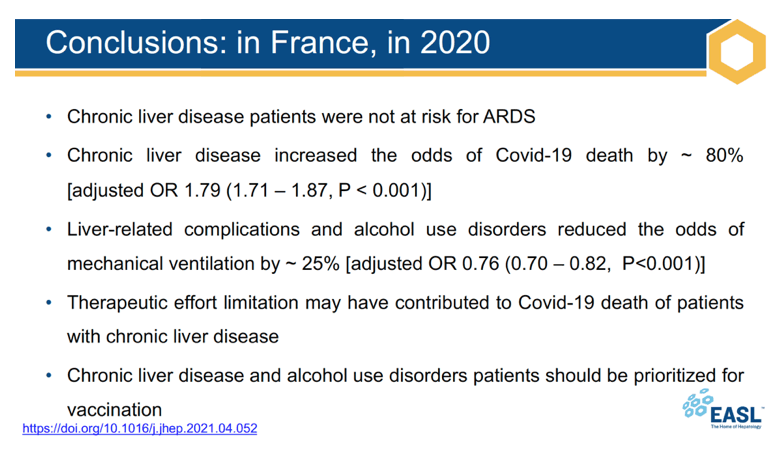
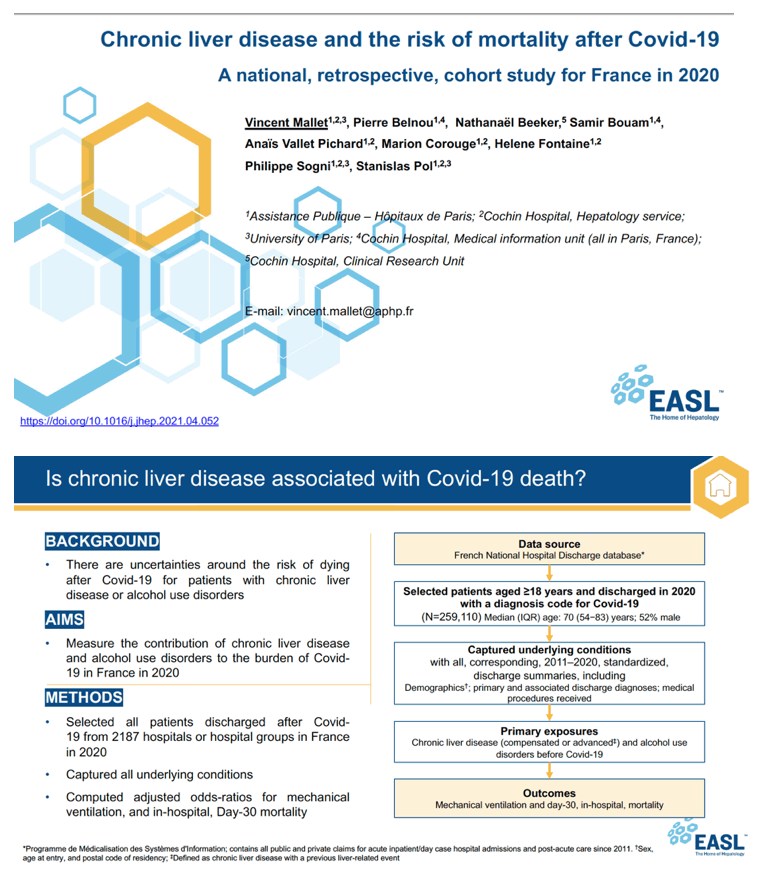

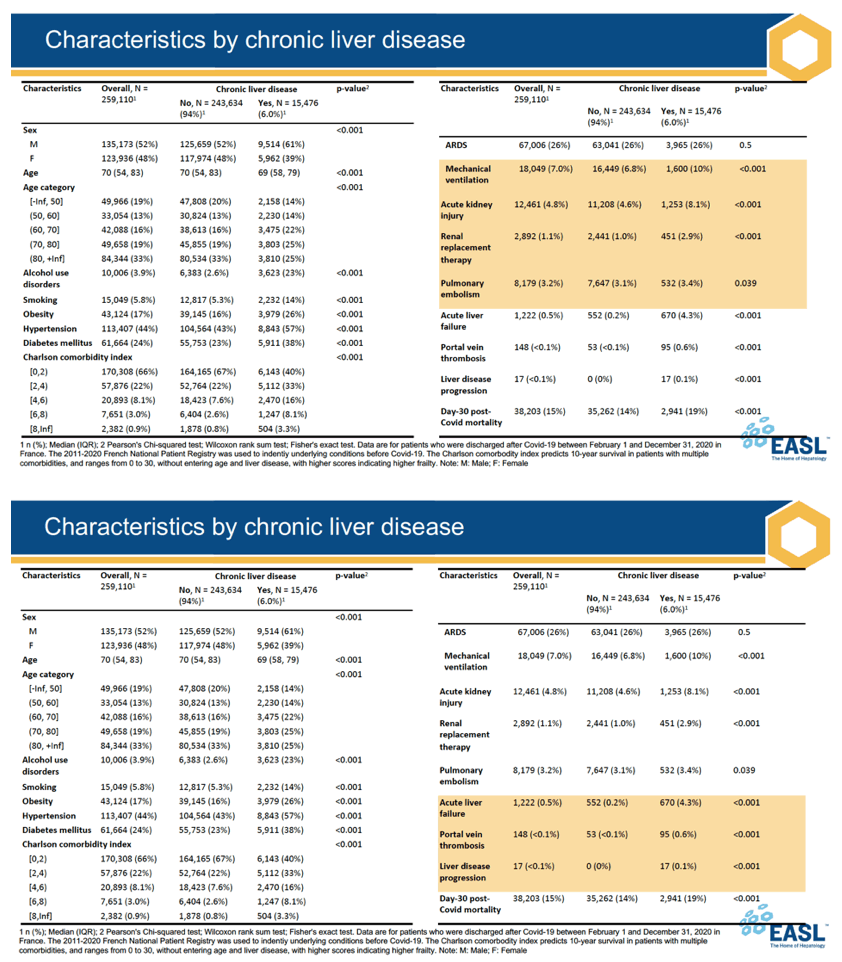
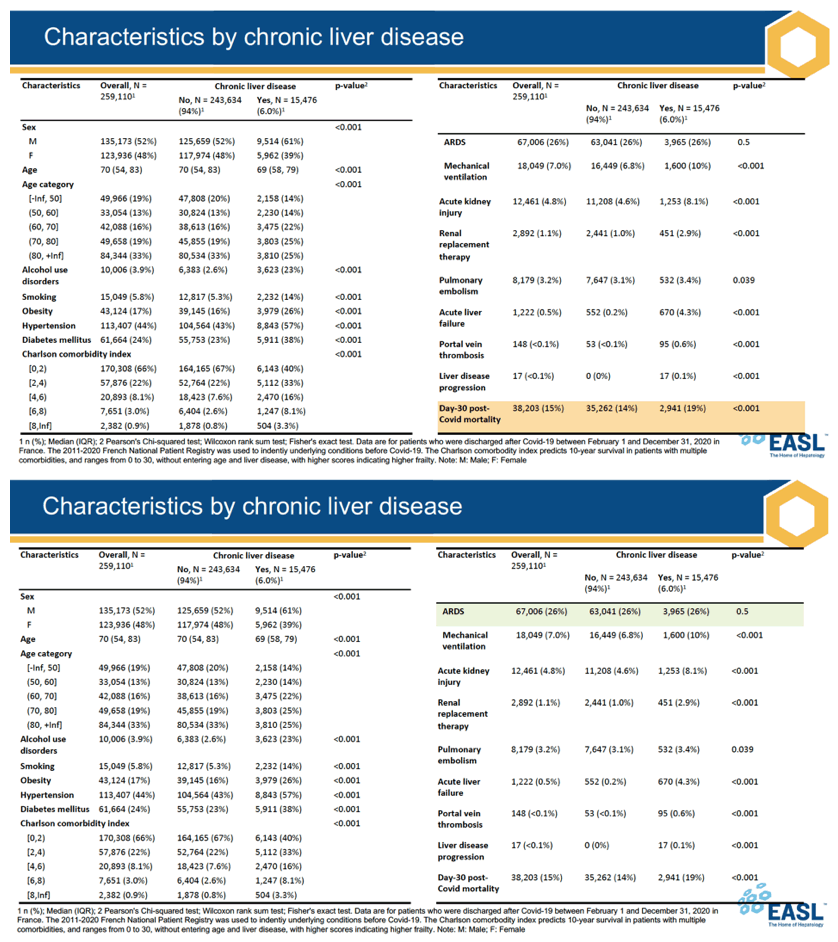
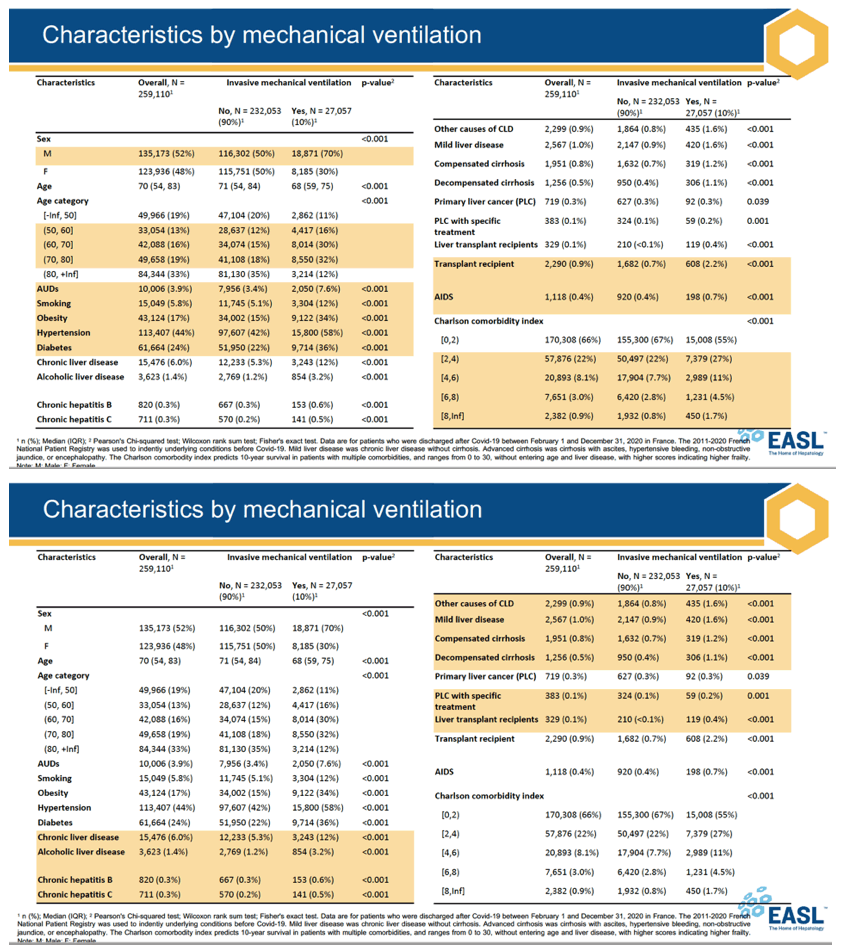
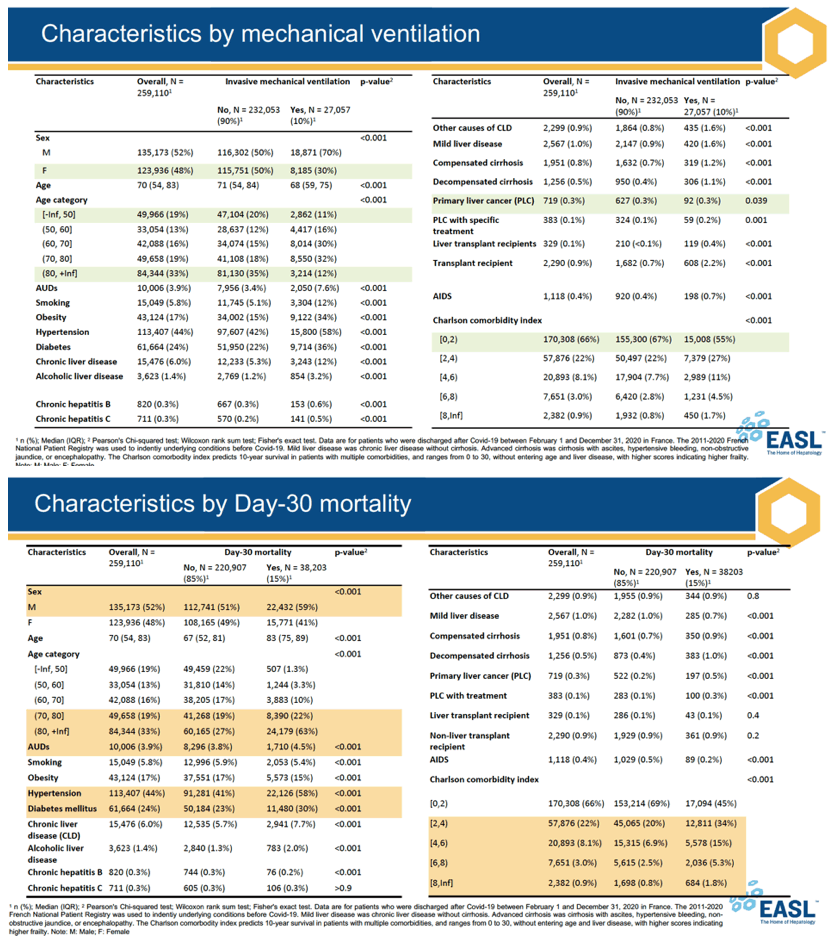
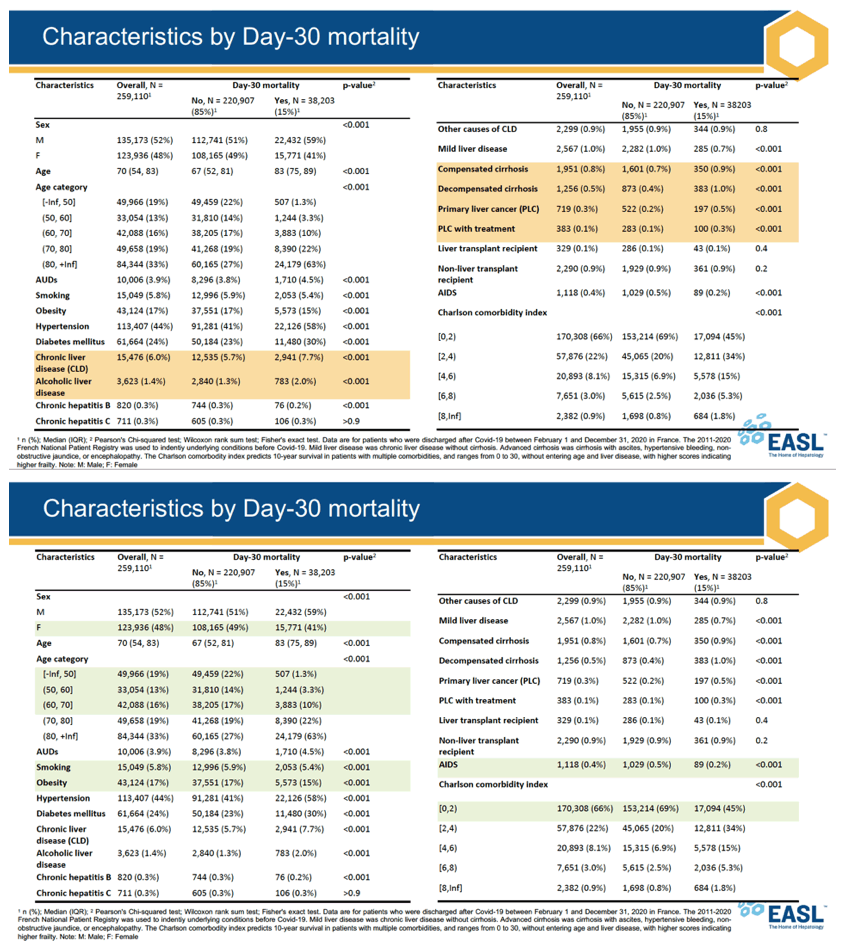
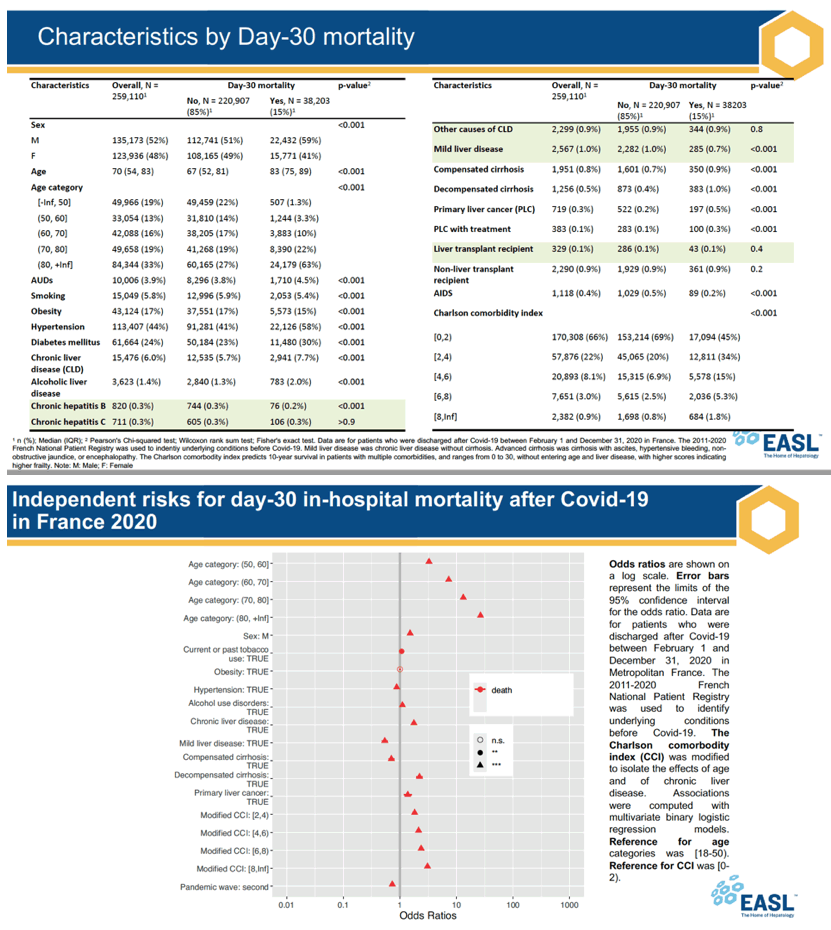
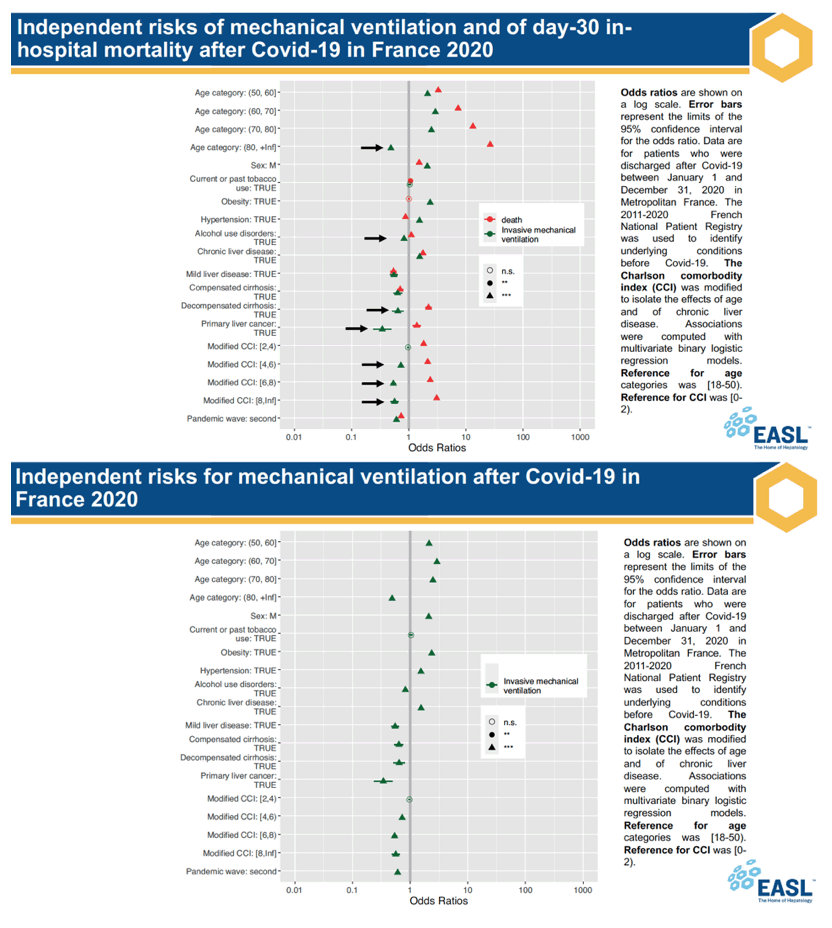
|
| |
|
 |
 |
|
|